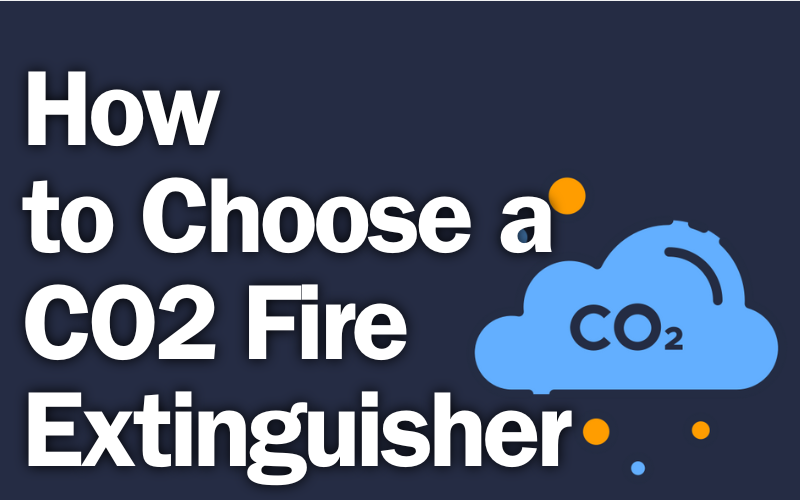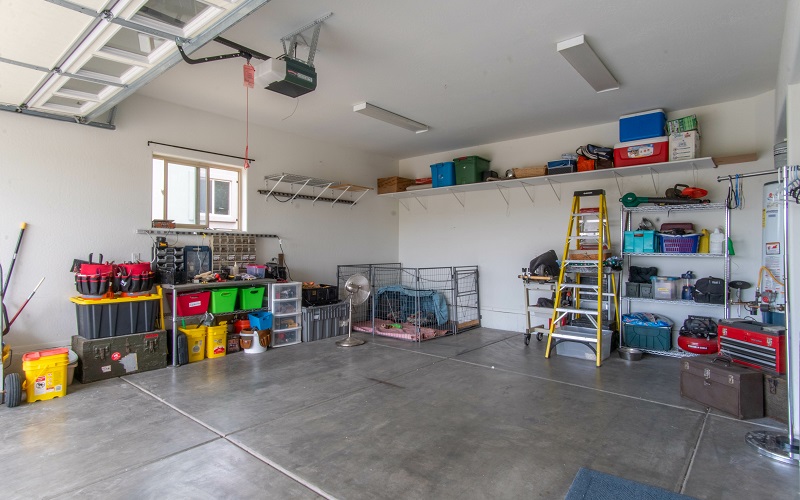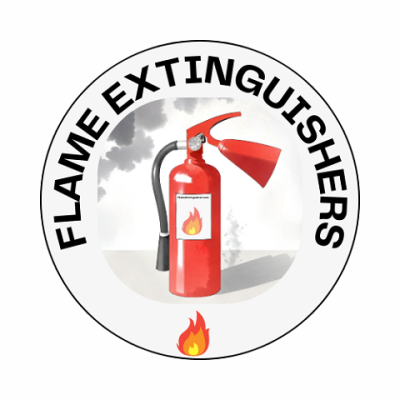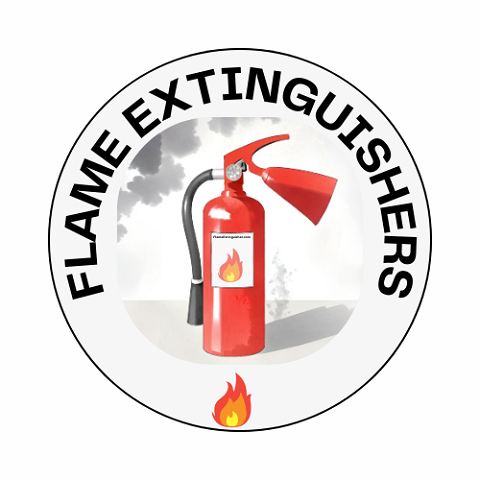Welcome back, fire safety enthusiasts! Today, we’re again diving deep into the realm of fire extinguishers, and more specifically, we’ll be shining a light on the often underestimated hero of the firefighting world – the CO2 fire extinguisher. We have put together a guide to understanding the important traits of a CO2 fire extinguisher so that you can make an informed decision regarding fire safety in your home or elsewhere.

What in the World is a CO2 Fire Extinguisher, Anyway?
Before we start talking specifics, let’s get the basics down. CO2 fire extinguishers, or carbon dioxide fire extinguishers for those who like to keep it formal, are like the James Bonds of the firefighting world – sleek, efficient, and capable of handling some serious business. These extinguishers use carbon dioxide gas to extinguish fires by removing the oxygen element that flames need to survive. It’s like giving a fire a one-way ticket to suffocation town.
Decoding the Classes: Where CO2 Fire Extinguishers Reign Supreme
Now, let’s talk about the classes these bad boys are designed to handle. CO2 extinguishers are typically classified as Class B and Class C extinguishers. Class B refers to flammable liquid fires, while Class C involves electrical fires. In simpler terms, if you find yourself in a situation where your kitchen grease is imitating the Fourth of July or your computer decides it’s time for a spontaneous combustion party, a CO2 extinguisher is your go-to.
But don’t just take my word for it. Let’s dive into a hypothetical scenario to illustrate when a CO2 fire extinguisher rules the roost:
Picture this: You’re in your swanky home office, working diligently on your computer when suddenly, a spark turns into a full-blown electrical fire. Smoke starts billowing, and panic sets in. Enter the CO2 extinguisher – swift, precise, and the hero of the hour. With a controlled burst of carbon dioxide, the fire is snuffed out, leaving your sanity intact and your computer unscathed.
Now, let’s flip the script and explore a situation where a CO2 extinguisher might not be your best ally:
Imagine you’re in your garage, surrounded by the intoxicating scent of motor oil and the sweet hum of power tools. Suddenly, a stray spark meets a puddle of gasoline, and chaos ensues. In this scenario, a Class B foam fire extinguisher might be a better fit, as it forms a barrier on top of the flammable liquid, preventing oxygen from feeding the flames. CO2 extinguishers, while effective, might struggle to keep up with the volatile nature of liquid fuel fires.

Who Needs a CO2 Fire Extinguisher, Anyway?
CO2 extinguishers aren’t for everyone, but for the right person, they’re a game-changer. If you’re the proud owner of a home office, tech-filled man cave, or a kitchen that doubles as your experimental cooking lab, a CO2 extinguisher should be on your must-have list. These extinguishers are also ideal for businesses with a plethora of electronic equipment or areas with a high risk of flammable liquid spills.
How to Choose the Best CO2 Fire Extinguisher for Your Needs
It’s now time to equip ourselves with the knowledge needed to choose the absolute best for our specific needs. In the vast sea of options, consider the following five categories as your guiding stars in the firefighting galaxy:
Effectiveness/Type: Decoding the Firefighter’s Arsenal
Your first mission, should you choose to accept it, is to evaluate the effectiveness of the CO2 extinguisher based on the types of fires it can handle. Each extinguisher is a specialized tool, like a surgeon’s scalpel, designed to combat specific fire classes. Ensure you pick the right one for your needs:
- Class B: Flammable liquid fires
- Class C: Electrical firesSo, ask yourself: What kind of fires are you most likely to encounter in your space? The answer will guide you to the extinguisher that’s tailor-made for your unique firefighting challenges.
So, ask yourself: What kind of fires are you most likely to encounter in your space? The answer will guide you to the extinguisher that’s tailor-made for your unique firefighting challenges.
Size and Capacity: Balancing Act of Coverage and Convenience
Now, let’s talk size – because when it comes to CO2 extinguishers, one size definitely doesn’t fit all. Consider the dimensions and weight of the extinguisher, as this will impact its maneuverability and ease of use. Larger extinguishers might provide more coverage, but they come with the trade-off of being heavier and potentially more challenging to handle in the heat of the moment.
Imagine navigating a tight space with a bulky extinguisher – not exactly the thrilling adventure you want during an emergency. Find that sweet spot where size meets capacity, ensuring you have enough firepower without sacrificing ease of use.
Ease of Use: Unleashing the User-Friendly Warrior
In the world of firefighting, seconds count. Assess the ease of use of your chosen extinguisher. Look for features that make it a user-friendly warrior in your firefighting arsenal:
- Clear operating manual: A concise, easily understandable guide to ensure you know what you’re doing when the pressure is on.
- Simple activation mechanisms: No one wants to fumble with complicated procedures in the middle of a crisis. Choose an extinguisher with a straightforward activation process.
- Ergonomic design: A well-designed extinguisher should be easy to grip and handle, ensuring you can unleash its power with precision.
Remember, an extinguisher that’s easy to use is more likely to be effective in the heat of the moment. It’s your trusted sidekick – make sure it’s up for the challenge.
Durability and Quality: Building the Unyielding Shield
When it comes to firefighting equipment, durability is non-negotiable. Examine the overall build quality and construction of your chosen CO2 extinguisher. Consider these factors:
- Materials used: Opt for extinguishers made from high-quality, corrosion-resistant materials.
- Construction: A sturdy, well-constructed extinguisher can withstand the rigors of firefighting without breaking a sweat.
- Additional features: Look for extras that enhance durability, such as a metal valve instead of plastic or a corrosion-resistant coating.
Think of your extinguisher as a knight’s shield – it needs to be unyielding in the face of danger. Choose quality, and you’ll have a reliable defender by your side.
Price: The Budget-Friendly Battleground
Last but certainly not least, we venture into the budget-friendly battleground. Price matters, but it’s not just about finding the cheapest option. Consider the following:
- Compare costs: Shop around and compare prices for CO2 extinguishers with similar specifications and features.
- Value for money: Don’t just look at the price tag; evaluate the overall value for money. Consider the extinguisher’s effectiveness, size, ease of use, and durability in relation to the cost.
- Budget-friendly options: Thankfully, there are options at various price points, so you can find a reliable CO2 extinguisher that fits within your budget.
In the world of firefighting, your budget is a strategic resource. Invest wisely, and you’ll have a firefighting ally that won’t let you down when it matters most.
Our top rated option is the Amerex 322, 5lb Carbon Dioxide. See our Guide to the best fire extinguishers 2024 here
The Lifespan of a CO2 Fire Extinguisher:
Now, let’s tackle the burning question of how long your trusty CO2 fire extinguisher will stand by your side. Like any good sidekick, the lifespan of a CO2 extinguisher varies depending on factors like size, usage, and environmental conditions. On average, these extinguishers typically last between 5 to 15 years. But don’t just slap an expiration date on it and call it a day – there’s more to the story.
The key to keeping your CO2 extinguisher in tip-top shape is regular maintenance. Think of it like taking your car in for an oil change, but instead, you’re ensuring your first line of defense against fires is ready for action. Here’s a brief rundown of what maintenance entails:
Visual Inspections: Give your CO2 extinguisher the once-over at least once a month. Check for obvious signs of damage, corrosion, or leakage. Ensure that the pressure gauge is in the green zone, indicating it’s ready for action.
Weight Check: CO2 extinguishers are filled with, you guessed it, carbon dioxide gas. To ensure it’s ready to perform, periodically check the weight. If it’s significantly lighter than it should be, it’s time for a recharge.
Professional Inspection: Once a year, bring in the experts. Have a certified technician inspect your CO2 fire extinguisher to make sure it meets the standards set by regulatory authorities. They’ll also check for hidden issues that the untrained eye might miss.
Hydrostatic Testing: Every 5 to 12 years, depending on the type of extinguisher, it’s time for a hydrostatic test. This involves filling the extinguisher with water or another liquid to check for leaks and structural integrity. It’s like giving your extinguisher a stress test to ensure it’s up to the challenge.
Now, let’s tackle some burning questions you might have about CO2 fire extinguishers:
FAQ
Can I use a CO2 fire extinguisher on any type of fire?
CO2 extinguishers are most effective on Class B (flammable liquid) and Class C (electrical) fires. However, they may not be the best choice for certain scenarios, such as flammable metal fires.
Are CO2 fire extinguishers safe to use indoors?
Yes, CO2 extinguishers are safe for indoor use. The gas dissipates quickly, leaving no residue, making them a preferred choice for spaces with sensitive electronic equipment.
How long does the discharge on a CO2 fire extinguisher last?
The discharge time varies, but a typical CO2 extinguisher can last anywhere from 8 to 30 seconds. It’s crucial to aim for the base of the flames and use short bursts to maximize effectiveness.
Can I use a CO2 fire extinguisher on a grease fire?
While CO2 extinguishers can be effective on Class B fires, they may not be the best choice for grease fires. A Class K extinguisher or a wet chemical extinguisher designed for kitchen fires is recommended.
Are CO2 fire extinguishers environmentally friendly?
CO2 extinguishers are considered more environmentally friendly than some alternatives, as they leave no residue. However, the carbon dioxide itself contributes to greenhouse gas emissions, so it’s essential to use them responsibly.
In conclusion, choosing the right fire extinguisher is a critical decision that could save lives and property. When it comes to CO2 fire extinguishers, understanding their strengths, limitations, and the scenarios in which they shine is key. So, fellow fire safety aficionados, arm yourselves with knowledge and a trusty CO2 extinguisher – your ticket to keeping the flames at bay and the peace of mind intact. Stay safe out there!
Learn more about related Fire Safety Essentials here and with our Fire Safety Guides Here and
Our Term of the Day
Passive Fire Protection: Structural elements and materials designed to contain or slow the spread of fire, such as fire-resistant doors and fire-retardant coatings.


